BLE Extended Advertising Unified CoEx App#
1. Purpose / Scope#
This application demonstrates how to configure SiWx91x EVK as both Extended Advertiser(Peripheral) and Extended Scanner(Central) . It also has support for multiple connections(1 central + 1 peripheral) along with SMP feature and data transfer.
2. Prerequisites / Setup Requirements#
Before running the application, the user will need the following things to setup.
2.1 Hardware Requirements#
Windows PC with Host interface(UART/ SPI/ SDIO).
SiWx91x Wi-Fi Evaluation Kit. The SiWx91x supports multiple operating modes. See Operating Modes for details.
SoC Mode:
Silicon Labs BRD4325A
NCP Mode:
Silicon Labs (BRD4180A, BRD4280B);
Host MCU Eval Kit. This example has been tested with:
Silicon Labs WSTK + EFR32MG21
Silicon Labs WSTK + EFM32GG11
BLE Smart Phone with GATT client 2.2 Software Requirements
Embedded Development Environment
For Silicon Labs EFx32, use the latest version of Simplicity Studio
Download and install the Silicon Labs EFR Connect App in the android smart phones for testing BLE applications. Users can also use their choice of BLE apps available in Android/iOS smart phones.
2.3 Setup Diagram:#
SoC Mode :
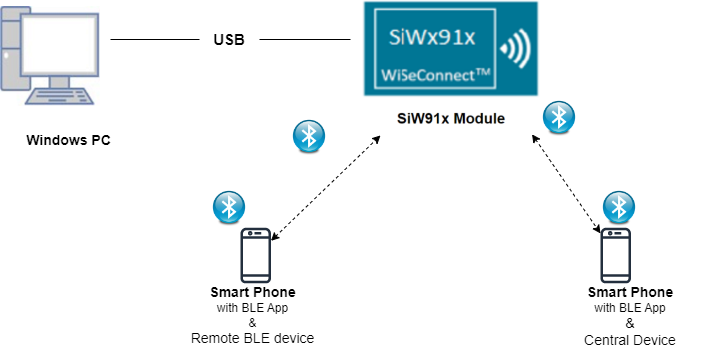

NCP Mode :
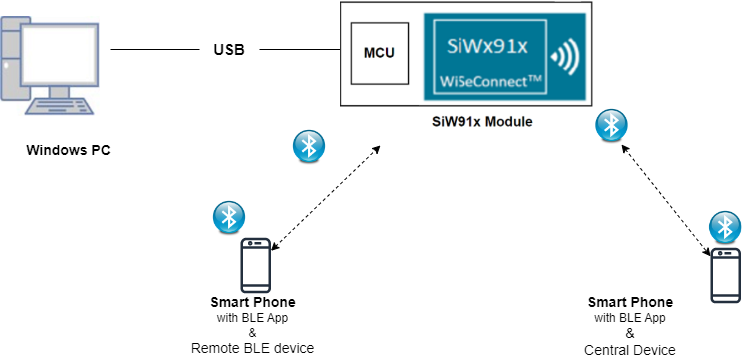

3. Application Build Environment#
3.1 Project Setup#
SoC Mode
Silicon Labs SiWx91x SoC. Follow the Getting Started with SiWx91x SoC to setup the example to work with SiWx91x SoC and Simplicity Studio.
NCP Mode
Silicon Labs EFx32 Host. Follow the Getting Started with EFx32 to setup the example to work with EFx32 and Simplicity Studio.
3.2 NCP Mode - Host Interface#
By default, the application is configured to use the SPI bus for interfacing between Host platforms(EFR32MG21) and the SiWx91x EVK.
4. Application Configuration Parameters#
The application can be configured to suit your requirements and development environment. Read through the following sections and make any changes needed.
4.1 Open ble_config.h file and update/modify following macros,
4.1.1 User must update the below parameters
Configure the below macros to enable extended advertsing and scanning by default respectively
#define ADV_ENABLED_DEFAULT 1
#define SCAN_ENABLED_DEFAULT 1Set the below macro to enable second advertising set
#define ADV_SET2 1Configure the below macros to set the number of peripheral and central connections that can be made
#define RSI_BLE_MAX_NBR_SLAVES 1
#define RSI_BLE_MAX_NBR_MASTERS 1Fill the name of the peripheral to be connected to in the following macro
#define RSI_REMOTE_DEVICE_NAME1 AEdevice1configure below macro to enable secure connection for central and peripheral respectively :
#define SMP_ENABLE_M1 1
#define SMP_ENABLE_S1 1set below macro to receive 'gatt notifications' from remote device
#define RX_NOTIFICATIONS_FROM_M1 1
#define RX_NOTIFICATIONS_FROM_S1 1Note: Max limit for number of peripheral connections is 1 and central connections is 1
Power save configuration
By default, The Application is configured without power save.
#define ENABLE_POWER_SAVE 0
If user wants to run the application in power save, modify the below configuration.
#define ENABLE_POWER_SAVE 1
4.1.2 The desired parameters are provided below. User can also modify the parameters as per their needs and requirements
The length of the advertising data needs to be filled in the following macro
#define BLE_AE_ADV_DATA_LEN 0x19Below mentioned macro needs to be populated with data
#define BLE_AE_ADV_DATA "AE_PERIPHERAL_DATA_1"The Extended advertising handle for set 1 and 2 can be set with the following macros respectively
#define BLE_AE_ADV_HNDL_SET_1 0x00
#define BLE_AE_ADV_HNDL_SET_2 0x01The minimum advertising interval for set 1 and 2 can be set with the following macros respectively
#define BLE_AE_ADV_INT_MIN_SET_1 0x20
#define BLE_AE_ADV_INT_MIN_SET_2 0x30The maximum advertising interval for set 1 and 2 can be set with the following macros respectively
#define BLE_AE_ADV_INT_MAX_SET_1 0x20
#define BLE_AE_ADV_INT_MAX_SET_2 0x30The Extended advertising channel map for set 1 and 2 can be set with the following macros respectively
#define BLE_AE_ADV_CHANNEL_MAP_SET_1 0x07
#define BLE_AE_ADV_CHANNEL_MAP_SET_2 0x07The Extended advertising filter policy for set 1 and 2 can be set with the following macros respectively
#define BLE_AE_ADV_FILTER_POLICY_SET_1 0x00
#define BLE_AE_ADV_FILTER_POLICY_SET_2 0x00The Extended advertising TX Power for set 1 and 2 can be set with the following macros respectively
#define BLE_AE_ADV_TX_PWR_SET_1 0x7f
#define BLE_AE_ADV_TX_PWR_SET_2 0x7fThe primary advertising phy for set 1 and 2 can be set with the following macros respectively
#define BLE_AE_PRIMARY_ADV_PHY_SET_1 0x01
#define BLE_AE_PRIMARY_ADV_PHY_SET_2 0x01The Extended advertising max skip for set 1 and 2 can be set with the following macros respectively
#define BLE_AE_SEC_ADV_MAX_SKIP_SET_1 0x00
#define BLE_AE_SEC_ADV_MAX_SKIP_SET_2 0x00The secondary advertising phy for set 1 and 2 can be set with the following macros respectively
#define BLE_AE_SECONDARY_ADV_PHY_SET_1 0x01
#define BLE_AE_SECONDARY_ADV_PHY_SET_2 0x01The Extended advertising SID for set 1 and 2 can be set with the following macros respectively
#define BLE_AE_ADV_SID_SET_1 0x00
#define BLE_AE_ADV_SID_SET_2 0x01The Extended advertising scan request notification enable for set 1 and 2 can be set with the following macros respectively
#define BLE_AE_SCAN_REQ_NOTIF_EN_SET_1 0x01
#define BLE_AE_SCAN_REQ_NOTIF_EN_SET_2 0x01The Extended advertising event properties for set 1 and 2 can be set with the following macros respectively
#define BLE_AE_ADV_EVNT_PROP_SET_1 (BLE_CONNECTABLE_ADV)
#define BLE_AE_ADV_EVNT_PROP_SET_2 0x00The Extended advertising duration for set 1 and 2 can be set with the following macros respectively
#define BLE_AE_ADV_DUR_SET_1 0x00
#define BLE_AE_ADV_DUR_SET_2 0x00The maximum extended advertising events for set 1 and 2 can be set with the following macros respectively
#define BLE_AE_ADV_MAX_AE_EVENTS_SET_1 0x00
#define BLE_AE_ADV_MAX_AE_EVENTS_SET_2 0x00Extended scanning filter type can be set with the below macro
#define BLE_AE_SCAN_FILTER_TYPE SCAN_FILTER_TYPE_ALLThe scan type for primary phy can be set using below macro
#define PRI_PHY_BLE_AE_SCAN_TYPE SCAN_TYPE_ACTIVEThe scan type for secondary phy can be set using below macro
#define SEC_PHY_BLE_AE_SCAN_TYPE SCAN_TYPE_ACTIVEThe primary phy extended scan interval can be set using below macro
#define PRI_PHY_LE_AE_SCAN_INTERVAL 0x100The primary phy extended scan window can be set using below macro
#define PRI_PHY_LE_AE_SCAN_WINDOW 0x50The secondary phy extended scan interval can be set using below macro
#define SEC_PHY_LE_AE_SCAN_INTERVAL 0x100The secondary phy extended scan window can be set using below macro
#define SEC_PHY_LE_AE_SCAN_WINDOW 0x50Extended scanning filter duplicates can be set using below macro
#define BLE_AE_SCAN_ENABLE_FILTER_DUP 0x00Extended scan duration can be set using below macro
#define BLE_AE_SCAN_DUR 0x00Extended scan period can be set using below macro
#define BLE_AE_SCAN_PERIOD 0x00Following are the non-configurable macros in the application.
The event properties bits:
#define BLE_CONNECTABLE_ADV (1 << 0)
#define BLE_SCANNABLE_ADV (1 << 1)
#define BLE_LOW_DUTY_DIR_CONN_ADV (1 << 2)
#define BLE_HIGH_DUTY_DIR_CONN_ADV (1 << 3)
#define BLE_LEGACY_ADV (1 << 4)
#define BLE_ANONYMOUS_ADV (1 << 5)
#define BLE_TX_WR_ADV (1 << 6)Global buffer length: #define BT_GLOBAL_BUFF_LEN 15000
Phy rate bits:
#define PHY_1M BIT(0)
#define PHY_2M BIT(1)
#define PHY_LE_CODED BIT(2) #define RSI_BLE_PWR_INX 30
#define RSI_BLE_PWR_SAVE_OPTIONS 0
#define BLE_DISABLE_DUTY_CYCLING 0
#define BLE_DUTY_CYCLING 1
#define BLR_DUTY_CYCLING 2
#define BLE_4X_PWR_SAVE_MODE 4Opermode command parameters
#define RSI_FEATURE_BIT_MAP FEAT_SECURITY_OPEN
#define RSI_TCP_IP_BYPASS RSI_DISABLE
#define RSI_TCP_IP_FEATURE_BIT_MAP TCP_IP_FEAT_DHCPV4_CLIENT
#define RSI_CUSTOM_FEATURE_BIT_MAP FEAT_CUSTOM_FEAT_EXTENTION_VALID
#define RSI_EXT_CUSTOM_FEATURE_BIT_MAP 0Note: ble_config.h file is already set with desired configuration in respective example folder , user need not change for each example.
5. Testing the Application#
Follow the below steps for the successful execution of the application.
5.1 Loading the SiWx91x Firmware#
Refer Getting started with a PC to load the firmware into SiWx91x EVK. The firmware file is located in <SDK>/connectivity_firmware/
5.2 Creating the Project and builing the Application#
Refer Getting started with EFX32, for settin-up EFR & EFM host platforms
5.2.1 Project Creation - SoC Mode :#
Connect your board. The Si917 compatible SoC board is BRD4325A.
Studio should detect your board. Your board will be shown here.
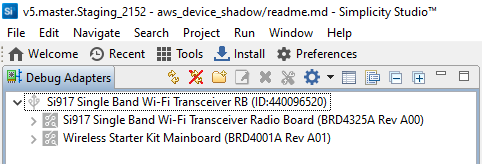

5.2.2 Project Creation - NCP Mode :#
Connect your board. The supported NCP boards are: BRD4180A,BRD4280B
Studio should detect your board. Your board will be shown here.


5.2.3 Selecting an example application and generate project#
Go to the 'EXAMPLE PROJECT & DEMOS' tab and select your desired example application
Click 'Create'. The "New Project Wizard" window appears. Click 'Finish'.
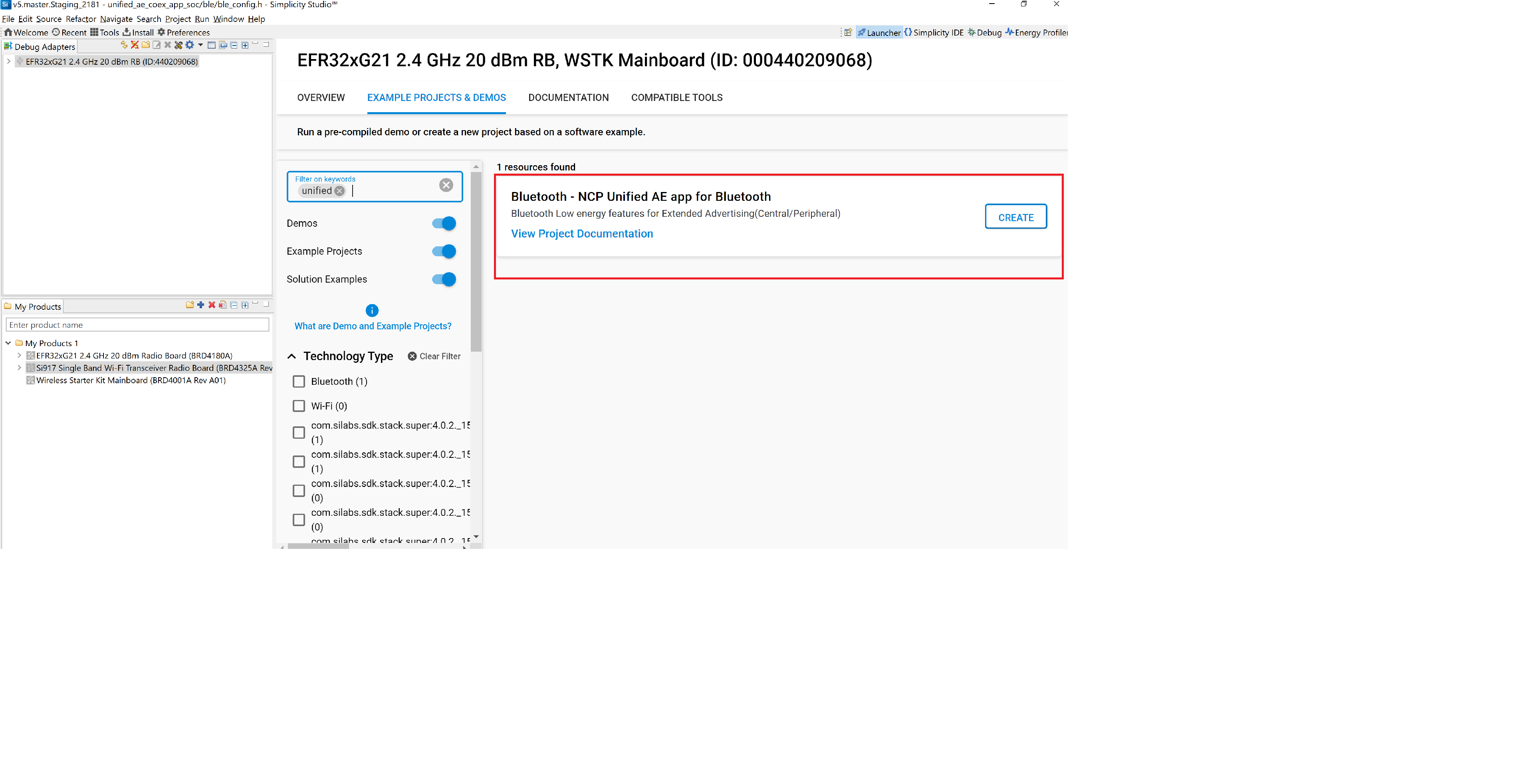

5.2.4 Build Project - SoC Mode#
Once the project is created, right click on project and go to properties → C/C++ Build → Settings → Build Steps
Add post_build_script_SimplicityStudio.bat file path (SI917_COMBO_SDK.X.X.X.XX\utilities\isp_scripts_common_flash) in build steps settings as shown in below image.
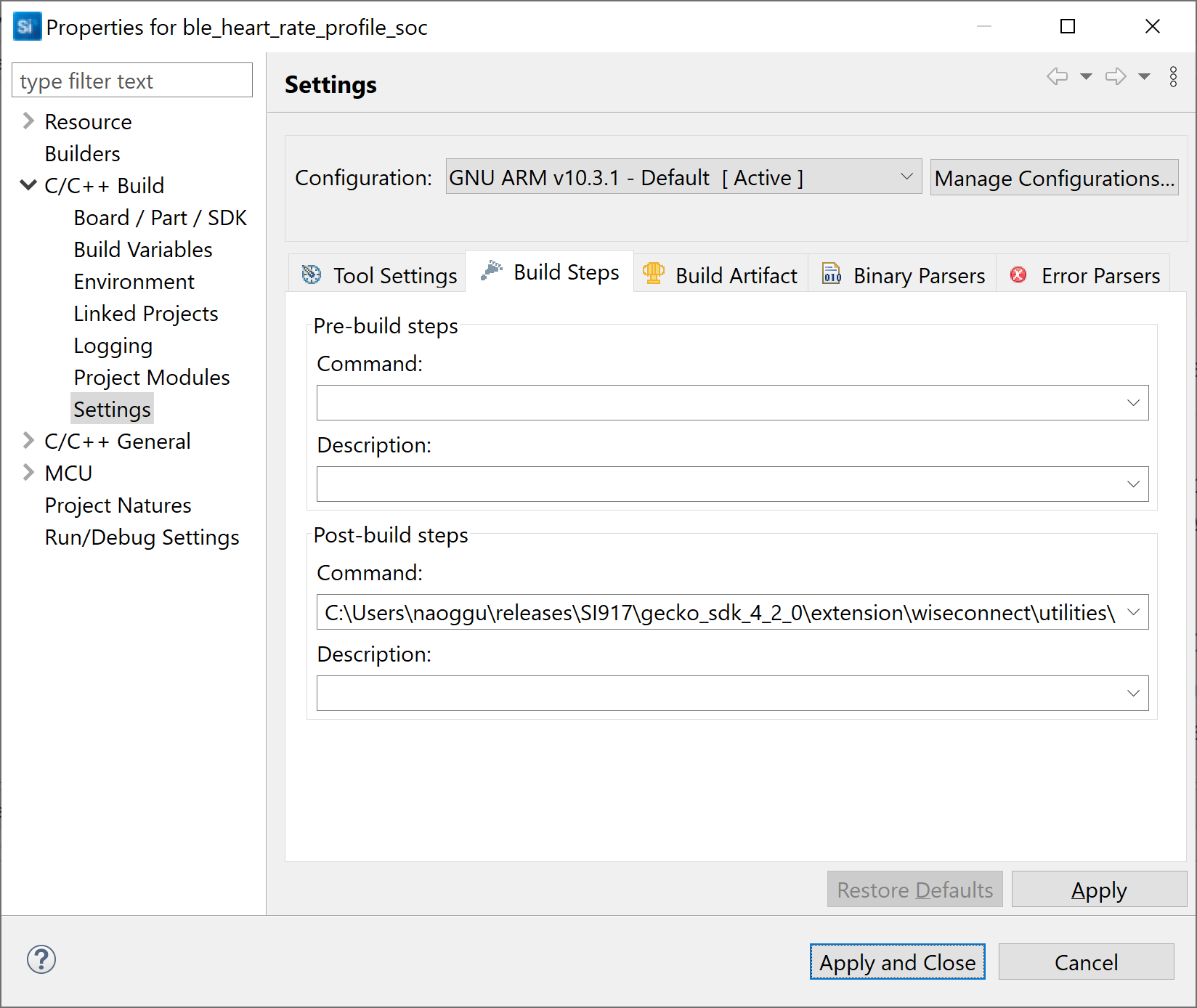

Check for M4 projects macros in preprocessor settings(RSI_M4_INTERFACE=1)
Check for 9117 macro in preprocessor settings(CHIP_917=1).
Click on the build icon (hammer) to build the project
Successful build output will shown 5.2.5 Build Project - NCP Mode :
Check for 9117 macro in preprocessor settings(CHIP_917=1).
If expansion board is used add the macro (EXP_BOARD=1) to preprocessor settings
Click on the build icon (hammer) to build the project
Successful build output will show as below.
6. Program the device#
Once the build was successfull, right click on project and click on Debug As->Silicon Labs ARM Program as shown in below image.
NCP Mode :#
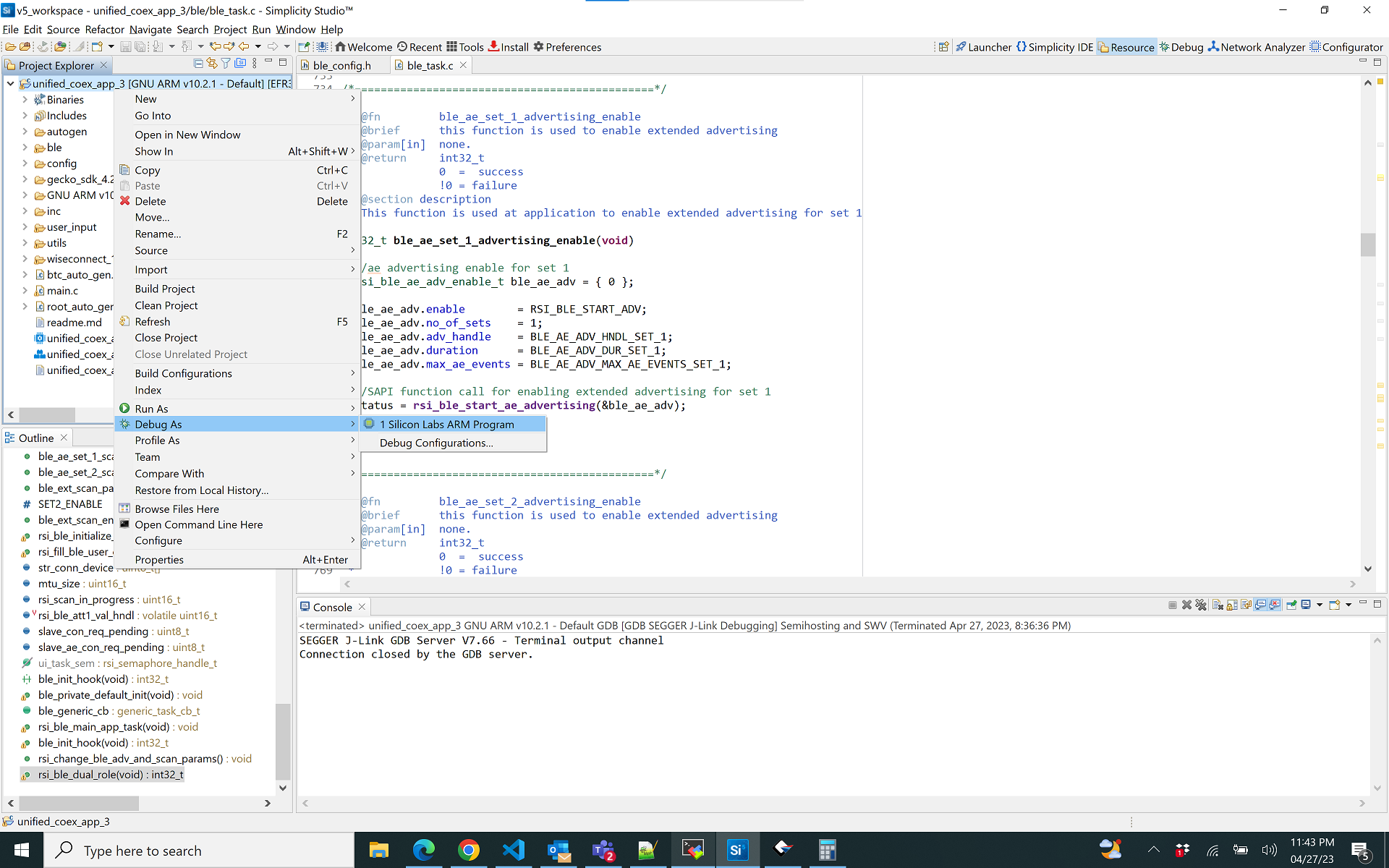

6.1 Running the SiWx91x Application#
6.1.1 Steps to be followed to verify BLE AE Unified CoEx App#
Set all the configurations necessary refering to section 4.
If extended advertsing is enabled by default SiWx91x would be visible on air
If extended scanning is enabled it will scan in the given interval and window
To make remote central connection scan from any BLE scanner search for the device(if no random address is set it will advertise with the public address)click on connect , if SMP is enabled for this connection the process is started and after successful bonding if data transfer is enabled it is started .Note: To see the services on client end need to issue discover services after bonding from remote
To make a remote peripheral connection advertise the remote with the particuler name specified in RSI_REMOTE_DEVICE_NAME1 macro,if SMP is enabled for this connection the process is started and after successful bonding if data transfer is enabled it is started .
7. Observing the output prints on serial terminal#
7.1 SoC Mode:#
Connect USB to UART connector Tx and GND pins to WSTK radio board.
Connect Tx(Pin-6) to P27 on WSTK
Connect GND(Pin 8 or 10) to GND on WSTK
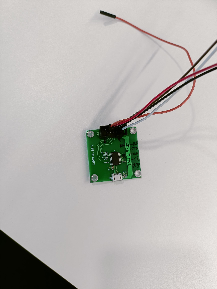

Prints can see as below in any Console terminal
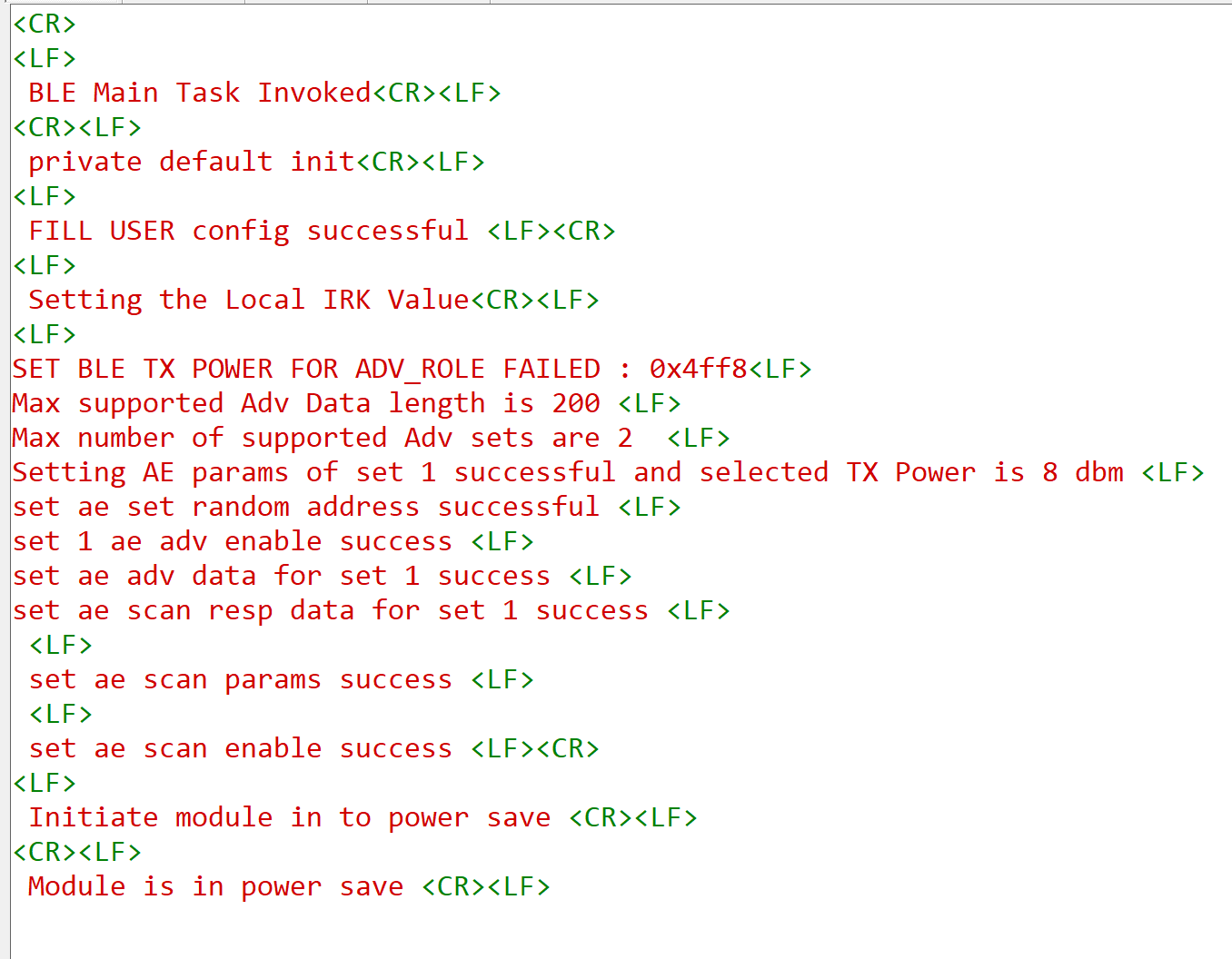

Prints can see as below in any Console terminal


